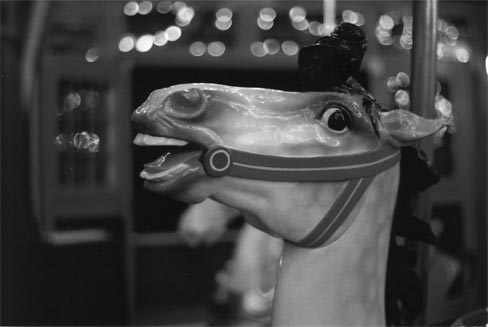Media Review
Carousel of Memories
Producer, writer, and editor: Cintia Cabib, Cintia Cabib Video Productions, 2005; 27 minutes; VHS $20.00; DVD $20.00.
The shed doors are opened, the lights turned on, and the distinctive music of the Wurlitzer organ reverberates through the park. So begins each day at Glen Echo Park, and so begins Cintia Cabib's engaging documentary video about the carousel that has operated almost continuously for more than 80 years. The story is one of enduring traditions, of succeeding generations taking their children to experience the ride, and the determined efforts to keep it at Glen Echo, keep it in mechanically sound condition, and ensure that it will survive for future generations to enjoy.
The carousel at Glen Echo Park was built by the Dentzel Carousel Company in 1921 in what was then an expanding amusement park on the edge of Washington, DC. Known as a menagerie-type carousel, it features 40 horses, 4 rabbits, 4 ostriches, a giraffe, a deer, a lion, and a tiger, each carved to appear in vigorous motion. Their vivid paint schemes, along with the intricately detailed plaster reliefs on the rounding boards and ceiling panels, and the scenery paintings on the central barrel panels lend the entire ride a whirl of color and texture that is hard to take in at one time. At night, over 1,000 lights heighten the effect.
Cabib tells the carousel's story primarily through narration and interviews. Max Hurley and his mother Irene, who have operated and helped maintain the carousel for over 25 years, share their memories of the ride, explain its features, and show how Max composes music on paper rolls played by the 1926 Wurlitzer band organ. Cabib also interviews individuals and families from the area about the importance of the carousel to their lives. A former university student describes how she participated in the early 1960s demonstrations that forced Glen Echo's owners to integrate the park. A member of the group that worked to save the ride when the amusement park closed in 1968 is also interviewed, as is the restoration artist that spent 20 years returning the animals and other decorative features to their historic appearance. The interviews and narration are illustrated with a wide variety of archival photos, family snapshots, news clippings, and amateur home movies, all held together with contemporary footage of the carousel today.
 |
The documentary suggests that Glen Echo's carousel and other rides like it owe much of their appeal to the way they resonate with all age groups. Children describe how while riding the carousel they imagine a world of animals in chase. Adults appreciate the carousel as a work of art. Even the youngest are able to ride on one of the chariot seats (as can elderly patrons). As children grow, they graduate to the stationary animals and then to those that "gallop" beneath gears and offset cranks.
Carousel of Memories presents a compelling account of this ride's place in local history. However, the viewer would have benefited from the occasional consideration of the ride within a larger context. There is little discussion, for example, of where the Glen Echo carousel fits into the broader history of carousel design and construction. Some background on the ride's manufacturer, Dentzel, a family that by the 1920s was in its third generation of carousel entrepreneurship, could help answer questions about whether Glen Echo's carousel was typical or distinctive.
The decline and eventual closing of Glen Echo as an amusement park was not unique or isolated. Family-operated amusement parks across the United States fared very poorly during the 1960s and 1970s. A brief review of the economic and cultural trends that buffeted amusement parks during this period would help viewers better understand the fate of Glen Echo and help explain why carousels are rare artifacts today. Lastly, mention of efforts to save other historic carousels and the national constituency of enthusiasts, historians, and other supporters and organizations that has grown over the past 30 years would show how the work to save the carousel in the late 1960s was an early example of a movement that has grown increasingly organized and influential.
Despite these minor limitations, Carousel of Memories is an enjoyable and informative program that explores the enduring hold these rides have on our imaginations. It explains why even today, as the National Park Service operates the site as an arts center, the carousel remains a favorite visitor destination. Glen Echo's historic carousel, saved and protected, provides a physical connection to the past at five revolutions per minute.
Chad Randl
Technical Preservation Services
National Park Service
